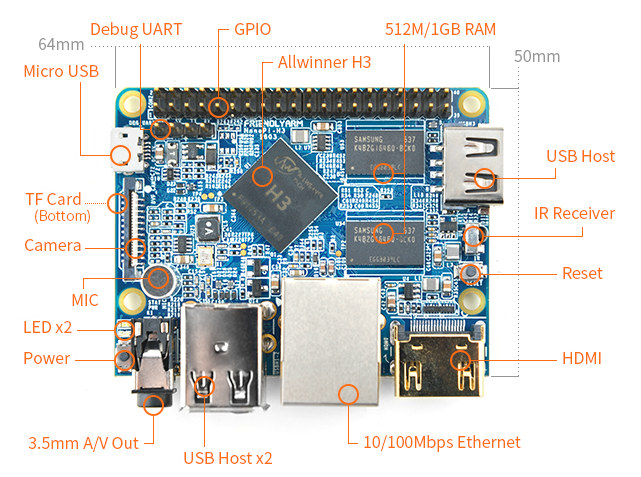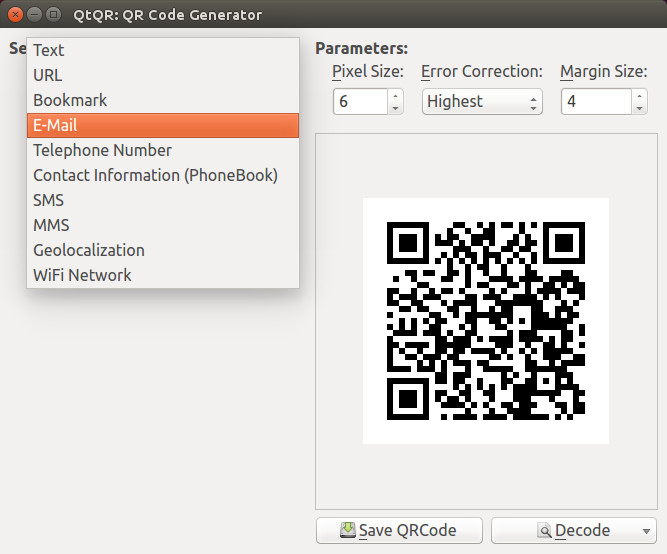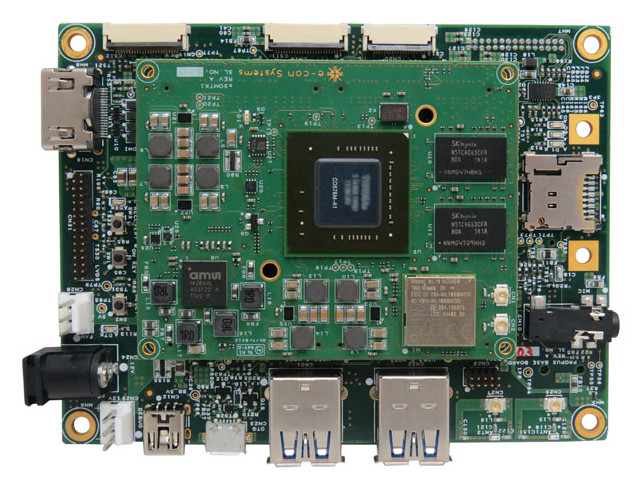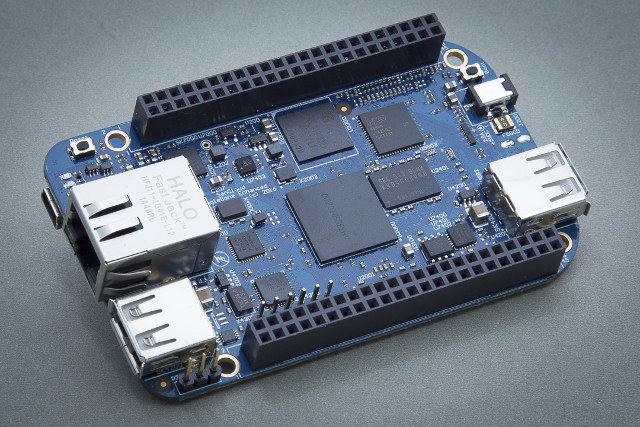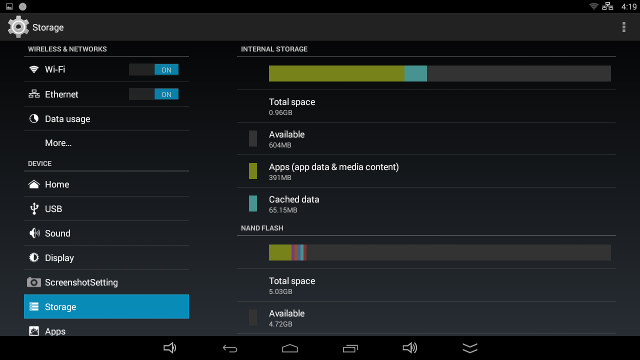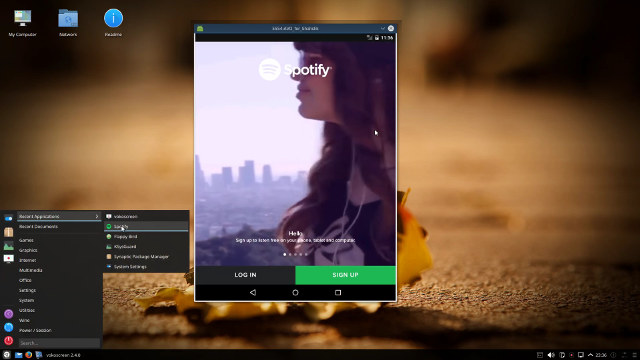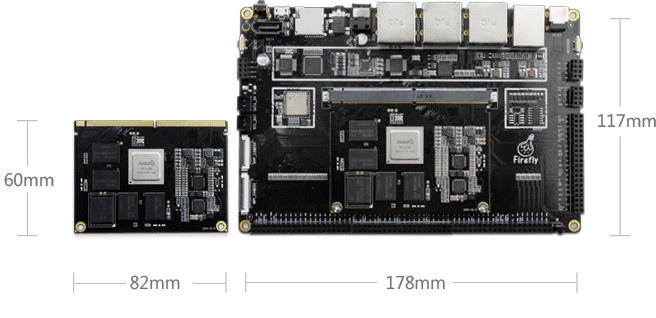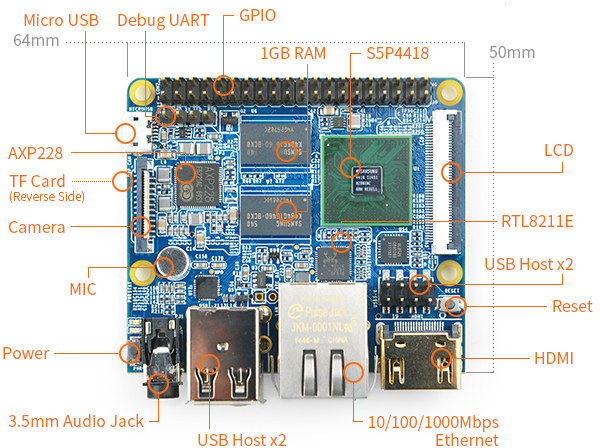FriendlyARM has been very busy since the beginning of the year, as they’ve already released NanoPi 2 Fire, NanoPC-T2, and NanoPi-M2 boards, all based on Samsung S5P4418 processor so far in 2016. But they’ve not stopped, as the company has now launched NanoPi M1 board powered by Allwinner H3 processor with a similar form factor as NanoPi-M2, similar features as Orange Pi One, except they added two extra USB ports, an AV port with composite video and stereo audio, an on-board microphone, and an IR receiver. NanoPi-M2 board specifications (highlights show improvements or differences over Orange Pi One): SoC – Allwinner H3 quad core Cortex A7 @ 1.2 GHz with an ARM Mali-400MP2 GPU up to 600 MHz System Memory – 512 MB DDR3 (1GB as option) Storage – micro SD card slot Video & Audio Output – HDMI and 3.5mm jack for CVBS (composite + stereo audio) Connectivity -10/100M […]
Decode or Generate QR Codes in Ubuntu with QtQR and zbar-tools
Sometimes I’ve found myself having to decode a QR code on my computer, and usually I’d just get my Android smartphone, use a QR code app to decode it, and send the results to my computer by email. It works, but wouldn’t it be better to simply do this straight from my computer instead? After a few minutes searching, I eventually found out QtQR graphical utility that can both generate and decode QR codes. In Ubuntu and Debian, you can install it as follows:
|
1 |
sudo apt-get install qtqr |
You can create a QR code with a given pixel size and level of error correction for text, URL, bookmark, email, phone number, SMS/MMS, WiFi network, and so on, and then use the Save QRCode button to save the resulting picture. If instead you simply want to decode a QR code from an image or your webcam use the Decode button, and the tool will […]
e-Con Systems Propus Nvidia Tegra K1 Development Board Features 3 MIPI-CSI Camera Interfaces
I mostly know e-Con Systems because of their camera modules, but the Indian company has also been manufacturing system-on-modules and development kits, and has just launched Propus development board based on their eSOMTK1 computer-on-module powered by Nvidia Tegra K1 quad core Cortex A15 processor, and including three camera interfaces with two 4-lane and one 1-line MIPI-CSI2 connectors. Propus specifications: Computer-on-module – eSOMTK1-F16G-R2G-WB-IM: SoC – Nvidia Tegra K1 4-plus-1 ARM Cortex-A15 processor @ up to 2.3 GHz with 192-core Kepler GPU. System Memory – 2GB 64-bit DDR3L SDRAM Storage – 16GB eMMC flash Connectivity – 802.11 a/b/g/n and Bluetooth 4.1 module with 2 u.Fl antenna connectors Sensors – 3D digital accelerometer and a 3D digital gyroscope (6 axis) Power Management IC (5V and 12V inputs) SoM connectors – 4x 100-pin board to board connectors Storage – SATA connect, micro SD slot Video Output – 1x HDMI 1.4 Audio – Audio Codec […]
BeagleBone Enhanced Adds Gigabit Ethernet, More Memory & USB Ports, and Sensors (Crowdfunding)
It’s nice to see BeagleBone Black‘s open source hardware being leveraged by third parties, as we’ve already seen designs such as BeagleBone Green and BeagleBone Black Industrial 4G in the past, and now UK based SanCloud has decided to launch BeagleBone Enhanced on Indiegogo (flexible funding). BeagleBone Enhanced board specifications with bold highlights showing improvements over the BeagleBone Black Rev. C: SoC – Texas Instruments Sitara AM3358 Cortex A8 @ 1 GHz + PowerVR SGX530 GPU System Memory – 1GB DDR3 RAM @ 800 MHz Storage – 4GB eMMC flash + micro SD slot, optional 1MB SPI NOR flash USB – 2x USB 2.0 host port (A type), mini USB OTG port, 2x USB interfaces via expansion header Serial Port – UART0 via 3.3V TTL header Ethernet – Gigabit Ethernet Video Output – micro HDMI with EDID support, up to 1280×1024 resolution. Audio Output – Via HDMI Sensors Optional 6 […]
How to Resize Partitions and Update Firmware in MXQ-4K TV Box (Rockchip RK3229)
Since I’ve received MXQ-4K Android TV box yesterday, I have started to play with it, and so far I can’t say I’m impressed, as while the device automatically detected the maximum resolution (3840×2160 @ 60 Hz) for my television, I could not play any of my 4K samples smoothly with either the pre-installed Kodi 15.2, Video and Video Player apps, there’s no power off mode (only standby), and the “internal partition” is only 0.96GB large which can quickly become an issue if you plan on installing several apps. Since GeekBuying has released the stock firmware, I decided to try to adapt the method to resize the partitions for GeekBox (RK3368) to MXQ-4K. Rockchip RK3229 Firmware Modding I’ve used a computer running Ubuntu 14.04, and assume you have most tools pre-installed. The first step is to download the firmware (MXQ-4K_ota_ok_20160127.img update.img), and install the tools to extract it :
|
1 2 3 4 |
git clone https://github.com/geekboxzone/utils cd utils/rockdev mv MXQ-4K_ota_ok_20160127.img update.img ./unpack.sh |
The […]
Run Android Apps in Linux with Shashlik Android Emulation Layer
There are already ways to run Android apps in Linux distributions such as Ubuntu or Debian, including the Android SDK emulator, running Android-x86 or Remix OS in a virtual machine, or using Genymotion, but those solutions are a little cumbersome to setup. Shashlik Android emulation layer aims to simplify the process of running Android apps in their own window within Linux desktop distributions. The Android apps can be started from the start up menu or dash like any Linux program. The apps are currently running inside an emulator so you actually boot a stripped down version of Android each time you start the app, which means they’ll take a little while to start. OpenGL and graphics are all rendered on the host for better performance. In the future, the emulator (virtual machine) may be dropped, and instead Shashlik could simply become a container, which requires rewriting libbinder in userspace There […]
Firefly-RK3288 Reload Board Features a SoM + Baseboard Design, Supports SATA, Three HDMI Ports, and More
Firefly-RK3288 was one the first boards powered by Rockchip RK3288 quad core Cortex A17 processor, and now Firefly team, part of T-Chip technology, has provided a new version called Firefly-RK3288 Reload with the same processor, but more features, and thanks to design comprised of a carrier board and system-on-module (SoM) – connected via an MXM connector – suitable to people or companies wanting to create their own board without handing the complexity of the processor, memory, and storage part. The table below shows Firefly-RK3288 and Firefly RK3288 Reload specifications side-by side. Parameter Firefly-RK3288 (Plus) Firefly-RK3288 Reload SoC Rockchip RK3288 ARM Cortex-A17 quad core processor up to 1.8GHz with ARM Mali-T760 MP4 GPU RAM 2GB Dual-Channel DDR3 (Plus version is 4GB) 2GB Dual-Channel DDR3 Storage 16GB eMMC (Plus version is 32GB) MicroSD (TF) Card Slot 16GB eMMC MicroSD (TF) Card Slot SATA 2.0 (Suggest 2.5 inch SSD or HDD) PMU ACT8846 […]
$30 NanoPi-M2 Board Packs Raspberry Pi 2 Hardware Features in a Smaller Form Factor
FriendlyARM had already launched two NanoPi boards powered by Samsung S5P4418 quad core processor, namely NanoPi 2 and NanoPi2 Fire, that were especially interesting due to their small size (75 x 40 mm) for the features including HDMI output, a camera interface, and either WiFi + Bluetooth or Ethernet. The company is now back with a third larger board, but still compact, removing the wireless module, but adding an audio jack and more USB ports, while keeping the price about the same. Meet NanoPi-M2: SoC – Samsung S5P4418 quad core Cortex A9 processor @ 400 MHz to 1.4GHz with Mali GPU including two pixel processors, and a geometry processor. System Memory – 1GB 32-bit DDR3 Storage – 1x Micro SD Slot Connectivity – Gigabit Ethernet RJ45 port (via RTL8211E) Video Output / Display I/F- 1x HDMI 1.4a, 0.5 mm pitch SMT FPC seat for type-A full-color LCD (RGB: 8-8-8) with […]


